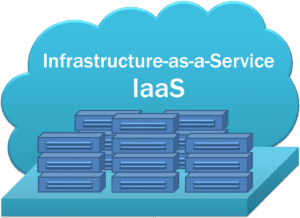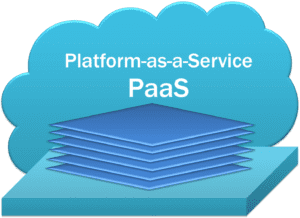
Cloud computing services are becoming mandatory parts of the modern business world. Most organizations are using one or more types of cloud-based services, whether that’s Infrastructure-as-a-Service (IaaS), Platform-as-a-Service (PaaS), or Software-as-a-Service (SaaS).
SaaS is the most common model among cloud computing services, but IaaS and PaaS serve equally important functions for businesses. IaaS and PaaS facilitate the demand of end users to collect, store, and process a large amount of data. In this article, we discuss IaaS vs PaaS for a better understanding of these cloud-based services.
Read more: Creating a Cloud Strategy: Tips for Success

What Is IaaS?
Infrastructure-as-a-Service (IaaS) is a form of cloud computing that provides virtualized computing resources to consumers over the internet on a pay-as-you-go and on-demand basis. These virtualized resources include essential computing, storage, and networking resources.
IaaS helps consumers gain real-time business insights without the higher maintenance costs of on-premises data centers and hardware. IaaS gives users the flexibility to scale IT resources up and down as needed.
It also helps users quickly provision new applications and increase the reliability of underlying infrastructure. IaaS is easier to use, faster, more flexible, and cost-efficient. The cloud provider manages IT infrastructure, delivering services to subscriber organizations through virtual machines accessible over the internet.
When Should You Use IaaS?
IaaS is an alternative to on-premises infrastructure that specifically helps network architects and system administrators. Here are the primary use cases for IaaS:
- You want to have control. With IaaS, providers manage servers and storage, but your organization gets to manage everything running on the infrastructure.
- Your company is growing. With IaaS, you can make changes as your needs evolve, or depending on traffic spikes and valleys.
- You want to increase your stability, reliability, support, and security. With IaaS, there’s no need to maintain and upgrade hardware, or troubleshoot equipment problems.
Examples of IaaS providers include:
Amazon EC2
Compute Engine
Linode
Azure Virtual Machines
DigitalOcean
Virtual Machine Manager
Alibaba Elastic Compute Service
Hostwinds
OVHcloud
Alibaba E-HPC
Read more on ServerWatch: Best Cloud-Based Services & Companies

What Is PaaS?
Platform-as-a-Service (PaaS) is a category of cloud computing that provides users a complete cloud-based platform for developing, running, and managing their applications. These services are typically associated with developing and launching applications, allowing developers to build, maintain, and package such software bundles.
In PaaS, a third-party provider delivers hardware, software tools, and infrastructure to users over the internet. Usually, these are used for application development. Users can purchase the resources as needed from a service provider on a pay-as-you-go basis, accessing them over a secure internet network. The users manage the applications and services they develop, and the cloud service provider typically manages everything else.
When Should You Use PaaS?
PaaS is an alternative to traditional hardware and software development tools to help developers and deployment. PaaS use cases include:
- You need to build software, and you have resources. If you don’t want the trouble of building servers, networks, and managing databases. In this situation, PaaS facilitates the virtual platforms and tools to create, test, and deploy your applications and services.
- Multiple remote developers are working on the same project. PaaS can provide you with a great environment, speed, and flexibility for your entire process, regardless of where your developers are located.
- You are rapidly developing or deploying an application. PaaS can help reduce costs and simplify the challenges associated with quickly shipping an application.
Examples of PaaS providers include:
- AWS Elastic Beanstalk
- Oracle Cloud Platform
- Google App Engine
- Microsoft Azure
- Salesforce aPaaS
- RedHat OpenShift
- Mendix aPaaS
- IBM Cloud Platform
- SAP Cloud Platform
- Engine Yard
IaaS vs PaaS: What’s the Difference?
IaaS and PaaS are both cloud-based options designed to relieve the company and IT department of their responsibilities when it comes to handling data, software, OS, virtualization, servers, storage, and networking. However, there are several differences when considering IaaS vs PaaS.
Services
An IaaS provider offers a virtual data center to store company information and create platforms for services and application development, testing, and deployment. On the other hand, a PaaS provider offers a virtual platform and the tools to create, test, and deploy applications and services.
End-User Management
IaaS allows end users to manage their applications, the platforms used to build them, and the cloud-based resources to keep everything running — such as OS, middleware, runtime environment, applications, and data. On the other hand, PaaS allows end users to manage the apps they develop with the tools provided by the cloud platform.
End User Security Responsibilities
The IaaS users are responsible for securing their data, user access, applications, operating systems, and virtual network traffic. On the other hand, the PaaS users are responsible for securing their applications, data, and user access.
Vendor Security Responsibilities
The IaaS vendors are responsible for enforcing secure access controls to the physical facilities, IT systems, and cloud services. On the other hand, the PaaS vendors are responsible for securing the operating system and physical infrastructure.
Flexibility and Cost
IaaS is very flexible, but it’s the most expensive form of cloud computing. On the other hand, PaaS is flexible within certain limitations, and mid-tier in cost.
Choosing the Right Solution
The biggest advantage of IaaS is that solutions can easily scale with businesses as they grow, or downsize if necessary. On the other hand, the biggest advantage of PaaS is its ability to save developers significant time throughout a project.
In cloud computing, IaaS is often the first step in hybrid-cloud and multi-cloud strategies, whereas PaaS is a step toward Infrastructure as Code. IaaS and PaaS are designed to achieve different goals for different types of users. When it comes to IaaS vs. PaaS, depending on your organization’s needs you may not have to choose.
Read next: Cloud Computing Thinks Small (and Medium Sized Business)